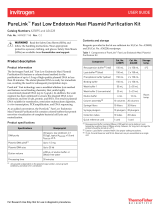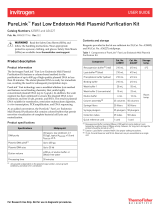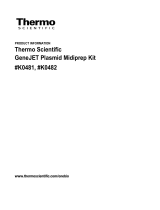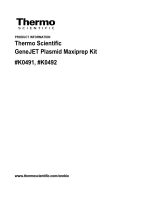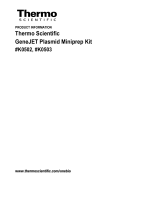Buffer Preparation:
✓ Add 46 ml of 95% ethanol to the 12 ml ZymoPURE
™
Wash 2 (Concentrate) (D4209), 88
ml of 95% ethanol to the 23 ml ZymoPURE
™
Wash 2 (Concentrate) (D4210), or 107 ml of
95% ethanol to the 28 ml ZymoPURE
™
Wash 2 (Concentrate) (D4211 & D4212) before
use.
✓ The ZymoPURE
™
P2 and ZymoPURE
™
Binding Buffer may have precipitated. If this
occurs, dissolve the precipitate by incubating the bottles at 30-37 ºC for 10-20 minutes and
mix by inversion. Do not microwave!
✓ Before Starting: Incubate ZymoPURE
™
P3 on ice for 30 minutes before use.
Protocol:
The following procedure should be performed at room temperature (15-30°C).
1. Centrifuge 0.5-5 ml
1
of bacterial culture in a clear 1.5 ml tube at full speed for 15-
20 seconds in a microcentrifuge. Discard supernatant.
2. Add 250 µl of ZymoPURE
™
P1 (Red) to the bacterial cell pellet and resuspend
completely by vortexing or pipetting.
3. Add 250 µl of ZymoPURE
™
P2 (Green) and immediately mix by gently inverting
the tube 6-8 times. Do not vortex! Let sit at room temperature for 2-3 minutes
2
.
Cells are completely lysed when the solution appears clear, purple, and viscous.
4. Add 250 µl of ice cold ZymoPURE
™
P3 (Yellow) and mix thoroughly by inversion.
Do not vortex! Invert the tube an additional 3-4 times after the sample turns
completely yellow. The sample will turn yellow when the neutralization is complete
and a yellowish precipitate will form.
5. Incubate the neutralized lysate on ice for 5 minutes.
6. Centrifuge the neutralized lysate for 5 minutes at 16,000 x g.
7. Transfer 600 µ l of supernatant from step 6 into a clean 1.5 ml microcentrifuge tube.
Be careful not to disturb the yellow pellet and avoid transferring any cellular debris
to the new tube.
8. Add 275 µl of ZymoPURE
™
Binding Buffer to the cleared lysate from step 7 and
mix thoroughly by inverting the capped tube 8 times.
To continue processing the lysate using the recommended vacuum protocol,
proceed to the next page. If a vacuum is not available, proceed to page 6 for an
alternative centrifugation method.
For Technical Assistance,
please contact us at
1-888-882-9682 or E-mail
tech@zymoresearch.com.
Notes:
1
Depending on the volume
of bacterial culture it may be
necessary to repeat Step 1
several times.
2
Do not allow the lysis
reaction to proceed for more
than 3 minutes. Excessive
lysis can result in denatured
plasmid DNA. When
processing a large number
of samples, work with
groups of ≤ 10 at a time.












